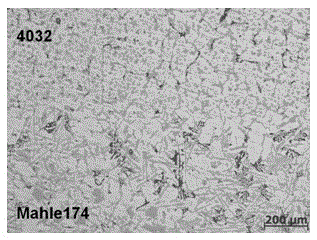Aluminizing and inlay casting technology for Al-based material
An aluminum-based material and aluminized technology, which is applied to engine components, pistons, mechanical equipment, etc., can solve problems such as melting of aluminum-based materials, and no metallurgical bonding surface between aluminum-based materials and aluminized materials. Promote the use and improve the effect of roughness
- Summary
- Abstract
- Description
- Claims
- Application Information
AI Technical Summary
Problems solved by technology
Method used
Image
Examples
Embodiment 1
[0041] An aluminizing and embedded casting process for aluminum-based materials, including selection of aluminized materials and surface activation treatment of aluminum-based materials, and after the selection of aluminized materials and surface activation treatment of aluminum-based materials, aluminizing and embedded casting are also included;
[0042] The selection of the aluminized material refers to selecting the aluminized material according to the aluminum-based material, and the melting point of the aluminized material is lower than that of the aluminum-based material;
[0043] The surface activation treatment of the aluminum-based material includes the following steps in sequence: first, the surface of the aluminum-based material is shot blasted, and then the aluminum-based material is ultrasonically cleaned, and then the aluminum-based material is soaked in a sodium hydroxide solution, and then the aluminum-based material is The base material is taken out, cleaned an...
Embodiment 2
[0046] Basic content is the same as embodiment 1, the difference is:
[0047] In the aluminizing and embedded casting, after the aluminizing material is melted, the molten aluminizing material is refined, degassed and slag removed, and then the molten aluminizing material is kept warm;
[0048] In the aluminizing and embedded casting, the holding temperature of the aluminized material melt is 10°C higher than the melting point of the aluminized material, and the heating temperature of the aluminum-based material is 100°C lower than the melting point of the aluminum-based material;
[0049] In the aluminizing and embedded casting, placing the aluminum-based material in the aluminized material melt and vibrating the aluminum-based material up and down refers to: placing the aluminum-based material in the aluminized material melt and making the aluminum-based material vibrate 50 mm, up and down reciprocating motion at a frequency of 1 Hz, after 30 to 60 seconds, take out the alum...
Embodiment 3
[0051] Basic content is the same as embodiment 1, the difference is:
[0052] The melting point of the aluminized material is 10°C lower than that of the aluminum-based material;
[0053] In the surface activation treatment of the aluminum-based material, first, the surface of the aluminum-based material is shot-peened with a steel shot having a diameter of 2 mm, so that the surface roughness of the aluminum-based material is greater than or equal to 6 microns, and then the aluminum-based material is ultrasonically After cleaning, the aluminum-based material is soaked in a 20% sodium hydroxide solution at a temperature of 80°C for 5 to 10 minutes to remove the aluminum oxide layer on the surface of the aluminum-based material, and then the aluminum-based material is removed from the sodium hydroxide solution. The aluminum-based material is taken out from the solution and cleaned with pure water, and then the aluminum-based material is dried and placed in a vacuum bag.
PUM
| Property | Measurement | Unit |
|---|---|---|
| surface roughness | aaaaa | aaaaa |
| melting point | aaaaa | aaaaa |
| melting point | aaaaa | aaaaa |
Abstract
Description
Claims
Application Information
 Login to View More
Login to View More - R&D
- Intellectual Property
- Life Sciences
- Materials
- Tech Scout
- Unparalleled Data Quality
- Higher Quality Content
- 60% Fewer Hallucinations
Browse by: Latest US Patents, China's latest patents, Technical Efficacy Thesaurus, Application Domain, Technology Topic, Popular Technical Reports.
© 2025 PatSnap. All rights reserved.Legal|Privacy policy|Modern Slavery Act Transparency Statement|Sitemap|About US| Contact US: help@patsnap.com

